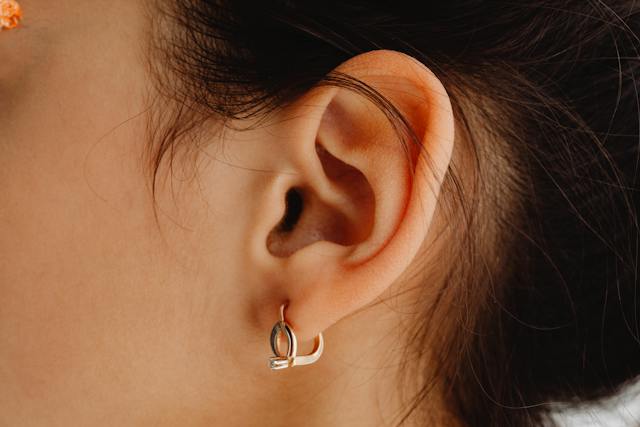
Why do we have ears on the sides of our head? Because of the position of our brains and our spines, because it puts the most possible distance between each ear, because we rely on sight more than sound, and because we are not prey animals and we don’t hunt by stealth.
Our ears are located at about the level of our eyes. We are not the only animals to have ears placed like this. All primates do, along with birds, giraffes, elephants, cows, sheep, and many other animals. However, I want to find out about humans, so I’m going to look exclusively at our ears. There are many parts to the ear, but basically the outer and inner parts. The outer part, the bit we can see, is called the pinna. It is made of cartilage and it points slightly forward to capture sounds coming directly at us. The pinna is shaped a little like a shell so that it can capture and reflect the sound waves into the inner ear. The ears point forwards because we generally turn our heads towards a sound we are focusing on so that we can see and hear it at the same time. We can also cup our hands over our ears, which increases its surface area and helps reflect even more sound into the inner ear.
Many animals have their ears on the tops of their heads and they are also able to move their ears independently. If you watch a cat, it will often turn its ears towards a sound without turning its head. This allows it to work out where a sound is coming from without having to look at it. We still have the muscles that animals like cats use to turn their ears, but they are vestigial and we can’t use them anymore. Some people are able to wiggle their ear, but that is about it. So, why do we have ears on the sides of our heads.
The first reason is because our spines are vertical rather than horizontal. Our brains sit horizontally inside our skulls and are connected to the spinal cord at the base, through the brainstem. The ears need to be close to that because the audio signal is first processed in the brainstem and the nerves want to be as short as possible so that no sound data is lost. The brains of most four-legged animals are also horizontal in their skulls, but their spines are also horizontal, which means the brainstem is at the back of the brain. Ears on top of the head are a perfect location for the position of their brainstem.
The second reason is very important. We work out where sounds are coming from because our brain analyzes the tiny differences between when the sound hits the left ear and when it hits the right ear. By looking at this difference, the brain knows where the sound is coming from. Animals can turn their ears to accomplish this, but our brain does it by complex mathematical calculations (that it does instinctively). The more distance there is between the two ears, the easier it is for the brain to work out the time difference between the two of them and having an ear on each side of your head puts more distance between them than having them on top of the head.
A very important reason is because we have evolved to rely on sight far more than we rely on sound. Up to 50% of our brains is devoted to vision and analyzing what we say and only about 3% of our brains is devoted to hearing. Compare this to a dog, where about 48% of their brain is devoted to hearing and much less to sight. They use more of their brain for smells as well. Animals turn their ears to find the location of a sound because they don’t have the best vision and they tend to rely a lot more on sound. To make up for this, they can often hear much higher and lower frequencies than we can. We don’t have great hearing, but we do have good vision. We use our ears to work out where a sound is coming from, and then we turn our heads so we are looking at the source of the sound.
The last reason our ears are not on the tops of our heads is because we are not prey animals and we don’t hunt by stealth. Prey animals have to be able to hear all around them, locating sounds, without turning their heads because they are eating, or don’t want to be seen. This is why they have ears that can turn. Prey animals also need to be able to turn their ears while they are hunting, so they can keep focused on what they are hunting. We hunt far more with vision and we can see more colors than most animals, so we only need to hear a brief sound and then we use our eyes to locate it. Our ears are not as important to us as our eyes. And this is what I learned today.
Photo by Karolina Grabowska: https://www.pexels.com/photo/a-woman-wearing-silver-earring-8093082/
Sources
https://pawsandclawsvet.com/the-incredible-sense-of-smell-in-the-dog
https://en.wikipedia.org/wiki/Auditory_system
https://www.ceenta.com/news-blog/why-are-my-ears-shaped-the-way-they-are
https://www.houseofhearing.co.uk/news/vestibular-hearing-system-rooted-evolution
https://www.ncbi.nlm.nih.gov/books/NBK470359/
https://med.uth.edu/orl/online-ear-disease-photo-book/chapter-3-ear-anatomy/ear-anatomy-inner-ear/
